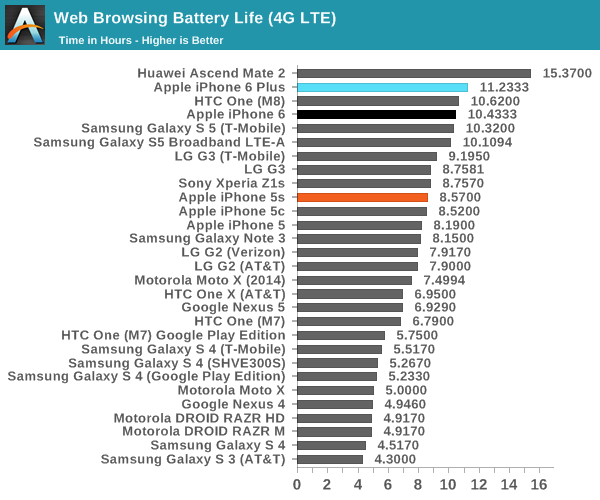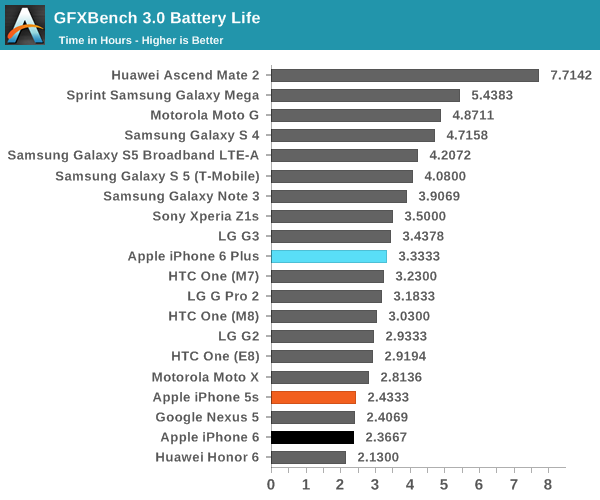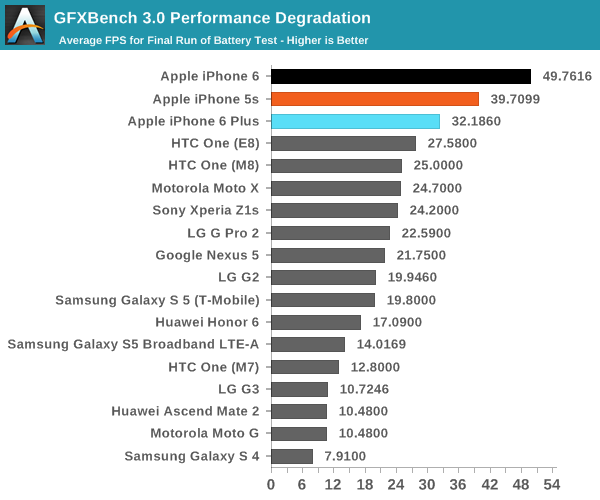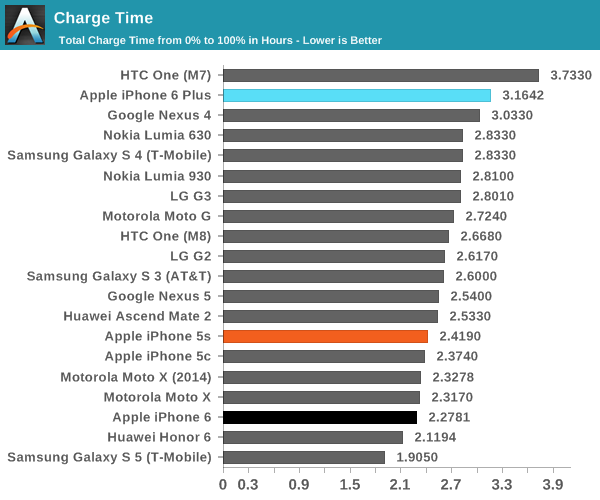The iPhone 6 Plus Mini-Review: Apple's First Phablet
by Joshua Ho on September 30, 2014 8:00 AM EST- Posted in
- Smartphones
- Apple
- Mobile
- iOS
- iPhone 6 Plus
Battery Life
One of the big draws of the larger form factor is battery life. Due to fundamental scaling issues, a bigger phone should be able to achieve greater battery life than a small one. This is because a smartphone's PCB generally remains constant in size, so it becomes an increasingly smaller proportion of the overall device size. This leaves increasingly large areas where batteries fill in the gap. In order to quantify just how big of a difference this makes when going from 4.7" to 5.5", we turn to our standardized battery life test suite. For those unfamiliar with our testing, the display is calibrated to 200 nits and all background tasks are disabled in order to ensure that only the foreground task is active in our tests.

As we previously discussed, the iPhone 6 Plus performs quite admirably in the WiFi web browsing test. As expected, there's a healthy bump over the iPhone 6, but it's not quite a massive leap as a larger battery size might suggest.

Once again, we see a similar pattern with the LTE web browsing test. Since both phones are based on the same platform, it makes sense that their results track quite closely together as we're only scaling display and battery size within the context of these tests.
However, the web browsing test is a mostly display-bound test, even if there is an SoC efficiency aspect that can make a significant difference. In order to better test SoC efficiency and get an idea of the dynamic range that a phone has in battery life, we turn to our compute-bound tests. Unfortunately, Basemark OS II stops the test too early due to low battery notifications in iOS, so we cannot use that test for a proper comparison to other phones.


As shown in these charts, the iPhone 6 Plus manages to sustain a significant boost in battery life when compared to the iPhone 6, and performance is almost identical as well. It seems that the iPhone 6 Plus begins to throttle towards the end of the test simply because it has more time to generate heat rather than any real difference in cooling, as skin temperatures were also around 43C on the iPhone 6 Plus in this test. It's also important to note that the iPhone 6 Plus is rendering at 2208x1242 internally in order to keep proper scaling with the 163 points per inch system that iOS has, which accounts for part of the performance delta.
Overall, battery life on the iPhone 6 Plus ranges between about 20% higher to 40% higher depending on the balance of display power and SoC/baseband power in any given situation. Heavily display-bound situations will be closer to the 20% higher figure while more SoC-bound tasks will tend toward 40% or even higher. Purely idle situations should see even greater improvements as any situation where the display is off will see linear scaling with battery size.
Charge Time
Charge time is one of the key metrics for getting a holistic picture of battery life, as it's impossible to really understand whether a phone will be able to stay mobile as needed without considering recharging. In some cases such as a trade show or travel, it doesn't matter if a phone lasts 20% longer than the competition if it loses all the time gained in time spent on a charger. In order to test this, power is tracked from when the phone is connected to the charger to when it reaches the lowest power draw state on the AC adapter.

Unfortunately, the included charger is the same 5W charger that we've seen for years now. As a result, the iPhone 6 Plus is constrained by the relatively low maximum power that it can put out. Those that wish for faster charging should look into getting an iPad A/C adapter as the iPhone 6 Plus will charge faster when connected to it.










191 Comments
View All Comments
Parhel - Tuesday, September 30, 2014 - link
A manufactured scandal if ever there was one. Just wait until the "will it blend" videos start popping up. Then we can have blendergate.joe_dude - Tuesday, September 30, 2014 - link
I'm looking for real test results, not conjecture. Anandtech could settle the issue by doing a 4 point test along the buttons. I'm guessing it bends at that spot with just 30 to 40 lbs. of force. Generic performance and battery tests, any review site can do. This is Anandtech, so I expect more in terms of technical nitty-gritty.yofa42 - Tuesday, September 30, 2014 - link
+1Parhel - Tuesday, September 30, 2014 - link
They plainly stated in the article, if you care to read it, that they're not going to destroy phones for the purpose of this review. So you'll have to get your "technical nitty-gritty" elsewhere.The link you posted is disingenuous. It's astroturfing, a "viral marketing" advertisement.
joe_dude - Tuesday, September 30, 2014 - link
Oh please. Joshua simply glossed over the issue without mentioning the video that started the whole #bendgate debate. Give us some hard numbers to show whether there really is a weak spot that would be prone to bending. Many people want to know if it really is an issue. Anandtech should help settle it once and for all. That's what Anandtech is supposed to be about - products that are thoroughly reviewed!Alexey291 - Tuesday, September 30, 2014 - link
Nah all we're getting now is engadget style clickbait reviews with predictable (aka forced) conclusions.I am betting that every device (unless its REALLY crap) will get the same kind of "its the best device to buy right now" conclusion.
Because you know... Anandtech's looooong since sold out.
Parhel - Wednesday, October 1, 2014 - link
It's hard to find a single review on Anandtech where somebody doesn't accuse them of being paid off. Doesn't matter if it's a hard drive, a video card, a phone, an OS. There's always somebody ready to make a baseless accusation without any evidence. That's the Internet for you. It's made everybody an expert in everything.But, you know, some guy on Youtube bending iPhones . . . that's a guy we can all trust, right? I've seen the videos too. I wouldn't buy a car from that guy, I can tell you that.
OreoCookie - Thursday, October 2, 2014 - link
For a scientifically conclusive test, you need to destroy tens of iPhones. That's an investment of a five-digit amount. Moreover, if AnandTech's phone is a review unit, they need to return it -- intact. Consumer report has at least quantified the force it takes to bend and break for a single phone and, important point, compared that to other phones. The tested iPhones 6 and 6+ were more robust than an HTC One M8, a phone for I have yet to see a report that it has a propensity for bending and breaking. Every single year the tech press finds something wrong with iPhones (e. g. the iPhone 4's antenna), to the degree that much more significant problems (e. g. the botched iOS 8.0.1 update) disappear in the bendghazi cacophony.InTheBoilerRoom - Tuesday, September 30, 2014 - link
Is there a particular reason that the Nokia Lumia 930 and 1020 were not included in the camera comparisons for the iPhone 6 and 6+? You have results for both (posted in the 920 review) and those are much more relevant benchmarks than the other phones included. I'm more interested in how close Apple's cameras are getting to the class leaders than to middle of the road phone cameras.underseaglider - Tuesday, September 30, 2014 - link
Apple has always set the bar to the highest when it comes to their models. They always make sure they come up with the first of its kind and iPhone 6 has been creating buzz even it was questioned with its bendability.